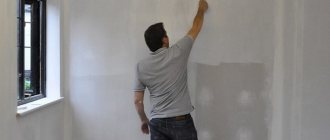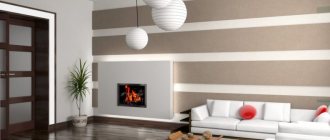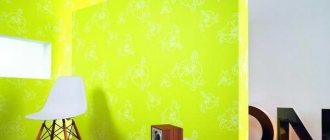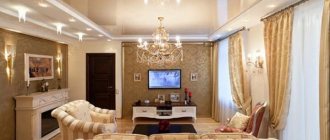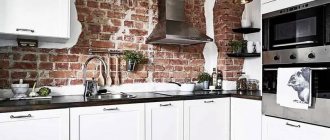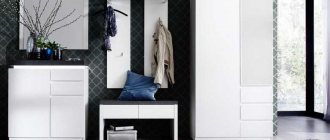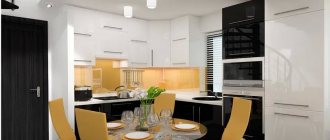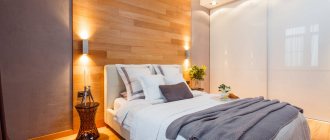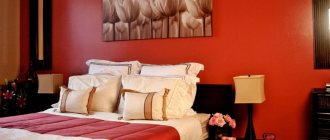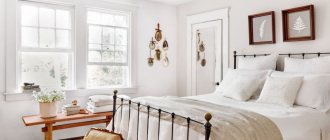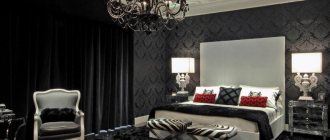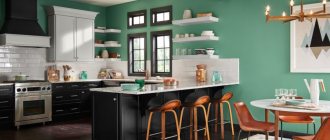| № | Name | Rating | Nomination |
| 1 | GLIMS PrimeGround | 4.88 | Optimal ratio of price and quality of coating |
| 2 | KNAUF Tiefengrund | 4.85 | Universal composition for interior and exterior work |
| 3 | Ceresit CT 17 | 4.65 | The most popular |
| 4 | Axton | 4.60 | Low price |
| 5 | VGT | 4.57 | Largest volume |
| 6 | Intercolor | 4.56 | Best drying time |
| 7 | Tikkurila Euro Primer | 4.55 | Suitable for processing fibreboards |
| 8 | TEX Pro | 4.50 | Affordable concentrated primer |
| 9 | Formula Q8 (Prestige) | 4.50 | High resistance to freezing |
| 10 | Prospectors | 4.10 | A reliable product for removing dust and strengthening walls |
Priming the walls before wallpapering: is it necessary?
Priming the walls before gluing wallpaper is necessary to increase the level of adhesion of the surface to the adhesive mixture and reduce glue consumption.
Is it necessary to prime
Today, there are a wide variety of options for finishing walls, but wallpaper is still popular among designers. In order for the wallpaper to fit perfectly when finishing, it is necessary to prime the surface.
Why is it needed for wallpaper?
Priming allows you to prepare the walls before gluing wallpaper, creating a dense layer (film), which leads to uniform application of wallpaper glue and subsequently saves the cost of wallpaper glue. The adhesive applied to the primer layer allows you to adjust the wallpaper pasting without much effort.
How to choose
Construction stores offer a wide range of primers, so you should approach this issue carefully. The choice of primer depends on:
- type of wall surface material (wood, putty, concrete, metal, etc.);
- wallpaper material;
- conditions in which this premises will be operated, etc.
Water-based acrylic and latex primers are not suitable for priming wooden walls, as moisture will cause unnecessary swelling of the wood. Therefore, it is recommended to use an alkyd primer for treating wood walls. However, if it is necessary to prime a concrete wall, then an alkyd primer will not be suitable, since increased adsorption of concrete will lead to excessive consumption of this type of primer. A water-based acrylic primer is suitable for treating such a surface.
Specifications
Some craftsmen use tinted emulsion diluted with water to provide a white base for wallpaper. This approach is only relevant before painting with a similar composition. In other cases, a film with weak peel strength and relatively normal adhesion will be created. Finishing materials may peel or crack.
It is correct to treat the surface with a primer. This is a construction product that is designed to strengthen the base, improve adhesive and strength characteristics. For wet rooms and facades, manufacturers additionally impart antiseptic properties to the compositions and add water repellents. They, accordingly, are needed to prevent the appearance of mold and mildew and to ensure surface resistance to moisture.
Preparatory work
Before priming the surface, a number of measures must be taken:
- From the room in which the work will be carried out, it is necessary to remove everything that could interfere with or be dirty during the work. The furniture should be moved to the center of the room to provide free access to each of the walls, having previously covered it with polyethylene and tape to protect it from contamination. If necessary, the floor covering must also be protected using film or other similar material.
- When identifying areas infected with mold or fungus, it is necessary to carry out their initial removal using a stiff brush, which must then be additionally opened with an antiseptic composition intended for this purpose.
- If there are defects on the surfaces being treated, they must be sealed with putty. The fewer defects there are on the walls, the better the final result will be achieved.
Note! If the putty surface is not opened with a primer, it may crumble, and the consumption of applied paint will be an order of magnitude greater.
The next step is to clean the walls with a brush, broom or vacuum cleaner.
During its implementation, it is important to eliminate the dust present on the surfaces, due to which it will be possible to increase the level of adhesion of the composition. It is advisable to carry out this stage 1-2 hours before the start of the main work, since during preliminary cleaning a few days before, it will re-deposit on the walls. Surfaces must be dry
If there is increased dampness in the room, it must be removed by ventilation. If you need to speed up the process, you can resort to using a heat gun.
The method of applying primer is universal and is not particularly different from that used when using coloring compounds. Before opening it from the surface of the walls, it is necessary to remove the old coating, grind it, and degrease it. The number of primer layers applied is individual, but there should be at least two.
To apply the mixture, you can resort to using a roller, paint brush or spray, in addition to which you need to use a container, which is used for pouring the composition and making the work easier.
Each of the tools is optimally used depending on the surface being processed. It is more convenient to open brick walls with a brush. The roller is more suitable for flat or plasterboard walls.
Note! A spray gun is also a good option for carrying out such work, but it is preferred less often, since after its use it is quite difficult to clean the room.
Successful examples and options
You can make the primer yourself.
To prepare a deep penetration primer, you will need PVA construction adhesive and water in the proportion of 1 liter of glue to 8 liters of water. Add water to the glue, stirring until smooth.
It is important not to allow a large concentration of glue. Diluted with water it should be absorbed into the base.
If there is a lot of it, a film will form that will peel off.
To create a rough base that improves adhesion to wallpaper, add natural chalk or cement and mix thoroughly. One trowel is enough for 10 liters. Just in case, filter the solution through double-layer gauze. This primer strengthens and protects the surface from moisture and has an antiseptic effect.
To increase the strength of the base and fight fungus, you can prepare a primer using copper sulfate, wood glue and laundry soap. Due to the fact that the primer will be cooked over a fire, aluminum and steel containers cannot be used, because the vitriol will enter into a chemical reaction with them.
Dissolve laundry soap in seven liters of boiling water. It can first be crushed by grating it on a coarse grater to reduce the dissolution time. Wood glue and copper sulfate are added to the boiling solution. Mix thoroughly and cook the primer over low heat for about half an hour.
Stir the solution every five minutes to avoid the appearance of lumps. After thirty minutes, the finished primer is filtered through a sieve. When the solution has cooled, the primer is ready for use. This primer is suitable for strengthening block, brick and plastered walls.
To improve adhesion, you can prepare a universal primer from alum (potassium alum), chalk powder, drying oil and dry paint glue. Mixing thoroughly, the mixture is brought to a homogeneous mass.
The solution cannot be stored for a long time; it will quickly lose its properties, so it is prepared immediately before use. This primer is suitable for any glossy or painted surface, for example, glass, hardboard, metal, tin.
Top 3. Ceresit CT 17
Rating (2021): 4.65
170 reviews from resources were taken into account: Yandex.Market, Otzovik, Leroymerlin.ru
The most popular The product has received a large number of reviews in the rating. The composition is recommended by many professional builders.
- Characteristics
Average price: 600 rub.
- Volume: 10 l
- Type: firming
- Drying speed: from 2 to 4 hours.
- Consumption per 1 m²: 0.1-0.2 l
An affordable and easy-to-use deep penetration primer for non-woven, paper, liquid and other wallpapers. The basis of the product is water-dispersion. The primer contains a yellow pigment, which makes it easy to distinguish the primed coating from an unprimed surface. After application, it creates a film that improves the adhesion of wallpaper glue, binds dust and strengthens the base. This pigmented primer can be used not only for walls, but also for floors, ceilings, and also for exterior applications. True, the yellow pigment included in the product makes it far from being so universal. The primer is absolutely not suitable for subsequent finishing painting in light colors: the shade CT 17 will either bleed through the layers of paint or distort the color.
Advantages and disadvantages
- Prevents mold formation
- There is no chalk dust after application
- Forms a smooth surface that does not absorb moisture
- Does not contain hazardous components
- Leaves yellow stains on finishing putty
- Has an unpleasant odor
See also:
- 10 best liquid wallpaper manufacturers
Basic rules for priming walls
So, let’s put together the most important information and add a few important nuances:
The walls are primed twice before wallpapering. The first time - to strengthen the base, as well as the best adhesion of the wall to the putty layer. The putty is primed a second time so that the wallpaper sheet is pressed tightly against the wall and does not peel off. During the initial (rough) surface preparation, a liquid composition with a high percentage of penetration is used. As a rule, this is an acrylic primer or homemade primer. For more detailed work, the wall is coated in several layers, with each new layer applied only after the previous one has completely dried. Liquid solutions for in-depth treatment take a very long time to dry
Therefore, when using them, it is recommended to take all precautions and take into account technical requirements (wear protective glasses/clothing, do not stay for hours on end in the room where the primer is drying).
Alkyd impregnation is ideal for wood surfaces. It perfectly masks protruding chips and other defects that will be hidden for a long time under a layer of primer.
In addition, this composition ideally hides nail heads, as well as other iron elements. The primer for wallpaper should be white, regardless of the color of the wallpaper. Otherwise, colored primers will show through and distort the shade of the wallpaper. In addition, white color perfectly covers dirty spots on the walls.
Prices for wood preservatives
Impregnation for wood
Despite the popularity of white primer, colored primer can also decorate the interior. Moreover, it is quite successfully used as a decorative coating. After drying, the primer layer becomes rough; it perfectly complements the relief of the decorative plaster that is applied on top.
Priming walls is an important part of repairs
Priming a wall is not as difficult as it seems at first glance. It is much more difficult to choose the right primer, allow enough time for each layer to dry, and apply the mixture uniformly over the entire surface of the wall. If possible, choose primer and wallpaper glue from the same manufacturer. This guarantees optimal compatibility of the compositions, which will give excellent results.
Popular manufacturers
The most popular liquid compositions for preparing walls for finishing are produced by the brands GLIMS, KNAUF and Ceresit. Primers from these manufacturers are considered the most effective.
Products from GLIMS
They dry quite quickly, are perfectly absorbed and protect the coating from mold formation. In addition, building materials from this brand are sold at a very affordable price.
KNAUF
produces more expensive primer with a wide range of applications. True, German quality has recently begun to fail: counterfeits are becoming more and more common. But even despite this, even experienced builders continue to use building materials from KNAUF. The main thing is to know where to buy.
Ceresit
considered one of the most popular brands. The manufacturer produces high-quality primers for a variety of tasks. The quality of mixtures and building materials produced under this brand remains unchanged. But, having decided to buy primer from Ceresit, you need to decide what you need it for. Not all compositions can be applied under light wallpaper and used for painting.
Stages of wall finishing before wallpapering
High-quality repairs can be done on your own, you just need to follow useful recommendations. You will need to examine the surface of the walls, detect chips and potholes in order to correct the defects. Puttying, sanding and drying helps with this. Then the primer material is selected in accordance with the purpose of the room, as well as the type of wallpaper that will be used for finishing.
Preparatory stage
Before you start wallpapering, you need to not only choose the material, but also clean the walls of the coating that was there before. Surface treatment is carried out using antiseptic compounds. Often the walls are not perfectly smooth, and if they previously had other finishing materials on them, additional defects may appear on the surface.
Applying primer
It is important to follow safety precautions, so you will need to wear safety glasses, gloves, and a head covering. Then you need to study the instructions that are indicated on the container with the primer
Some compositions must be mixed before use; for this, an electric drill or other tool is used. The mixture should cover the entire surface of the wall, being careful not to miss a single area.
To avoid mistakes, a pigmented primer is recommended, which will prevent mistakes. The walls must dry thoroughly before you begin wallpapering. A primer that evens out any wall color will help achieve the desired result, which is why it is in great demand among professionals and ordinary consumers. Follow the recommendations listed, study the types of products, and the repair work will be completed successfully.
See below for a master class on priming a concrete wall.
Preparing the composition at home
For those who do not have the opportunity to purchase a ready-made primer or simply do not trust purchased compounds and cannot choose the right one, you can make the mixture yourself. To do this, you need to stock up on some components:
- boiling water - 7 liters;
- drying oil - 100 grams;
- laundry soap - 150 grams;
- lime - 2 kg.
To prepare the composition, you will need a bucket in which the components will be mixed; for grinding, you need a grater and a fine sieve. Exactly half of the boiling water is poured into the bucket, the grated soap is dissolved in it, and everything is stirred. Afterwards, drying oil is added.
In a separate container, dissolve the lime in the remaining boiling water. Then both solutions are combined, mixed, and the liquid is passed through a sieve.
Priming begins after the composition has completely cooled.
Soap should be rubbed into a homemade primer first, then it will dissolve much faster
How to properly apply primer under wallpaper, with what tools
How to apply a primer to walls under wallpaper and whether this procedure is necessary is a question that worries many apartment owners who are undertaking renovations. To be sure of the correctness of your decision, you need to remember that the soil protects the base from the formation of fungal colonies, gives it water resistance, while leaving the surface breathable.
Wallpaper glued to a primed surface will not peel off or be removed along with the plaster. When applying wallpaper to a primed surface, less glue is used, and its adhesion to the base increases. The soil prevents the formation of dust, filling all the cracks and voids and preventing the material from crumbling.
Before applying primer to the walls, they must be cleaned of paint and varnish materials and swollen plaster with a hard spatula. Possible delaminations and voids are determined by tapping the surface with any impact tool. This could be a hammer or a small pick.
Then, using a brush or vacuum cleaner, the surface is cleaned of dust. Only after this they begin to apply primer. It is convenient to apply it with a spray or by hand using a medium-nap roller or brush. This way the liquid can penetrate into all the cracks and pores.
Putty is applied to the walls with spatulas of different sizes. A narrow solution, no more than 10 centimeters wide, is taken, applied to a second wider spatula, the width of which is 40 centimeters or more, and applied to the surface. To prevent cracks from forming during puttying, a painting mesh is applied to the first layer of starting putty.
If the walls are significantly uneven, plaster is used. First, a grout is used to fill cracks and potholes. After drying and priming, apply the next layer of plaster of a thicker consistency. The leveling stage is completed with a thin layer of putty 4 millimeters thick.
Before starting priming, it is advisable to saturate the surface with a solution that protects against fungal spores. In the bathroom and toilet rooms, it is better to replace wallpapering with painting the walls. Before painting them, you should also carry out preparatory work, treat them with an antiseptic and prime them.
Choosing future coverage
The most common type of final (finishing) finishing of a room is wallpaper. During their existence, little has changed in the method of carrying out work. Only additional elements of preparatory work appeared and the variety of wallpaper itself expanded.
Wallpaper comes in several types and types.
By moisture resistance:
- ordinary. These are paper and acrylic, they do not like moisture and mechanical stress;
- waterproof - tolerant of water getting on them;
- washable - during operation, you can use non-aggressive detergents in places of heavy contamination and a brush;
- super-washable - basically, these are different types of vinyl wallpaper, moisture-resistant and wear-resistant.
According to the material and requirements for the quality of finishing of the base on which they will be glued:
Paper. They can be multi-layered or single-layered and show all the defects of the walls, so the base must be perfectly flat and uniform. The glue makes them wet and swollen. If the base is puttied with sandless sand and not primed, the wallpaper will pull it along with it and tear it out. An exception may be the overlap method.
Non-woven. They are based on non-woven fiber made from cellulose or synthetic fibers
When choosing wallpaper, you need to pay attention to its density. They come in light, medium and heavy
The quality of the finish may not be ideal; their density may hide minor flaws in the base;
Vinyl. Thanks to the vinyl layer on the base, they can be used in rooms with high humidity. They are durable, fade-resistant, and washable. A relatively flat surface treated with pigmented impregnation is suitable for them;
- For painting. A type of non-woven wallpaper. Due to the fact that this wallpaper is covered with water-based paint, the base must be treated with a primer. If this is not done, the wallpaper will come off when painted;
- Liquid. In fact, this is a subtype of plaster. The price of liquid wallpaper is quite high. To save money, it is advisable to make a smooth and durable surface using sandless plaster and cover it with a primer.
Liquid vs thick primer: pros and cons
Another classification option is the consistency of the primer and the depth to which it can penetrate. This:
- Thick surface primer. A mixture of creamy white color that lays like a film on the surface of the wall and masks all its imperfections.
- Liquid primer with deep penetration. A transparent solution with a consistency similar to water. The structure helps to penetrate deeply into the wall surface and make it stronger.
Each type has its own advantages and disadvantages; we will analyze them in the table.
Applying a thick white primer
Table 3. Thick and liquid primers, their advantages and disadvantages.
| Purpose | Advantages | Flaws | |
| Superficial | Used to fill loose surfaces, strengthen walls and eliminate minor irregularities. After application to the wall they turn into a smooth film. Some manufacturers add antiseptics and additives to their primers that neutralize alkali. | qualitatively fills micropores; ideally smoothes any surface; the coating is no different from decorative finishing. | does not penetrate deep enough into the wall. |
| Deep penetration | Used in cases where it is necessary to further strengthen the wall. For example, if the material is quite old and there is a risk of cracks. In addition, they are often used when preparing walls in rooms with high humidity (kitchens and bathrooms). Prevents the development of mold and fungi spores. | affordable cost; the ability to penetrate 25% deeper into the wall texture than thick primers; strengthens the loose texture of concrete and makes it as resistant to external influences as possible. | transparency; uneven application (due to the lack of color it is impossible to apply layers without overlapping); absorb moisture, so after the first layer has dried, you need to add a second one; different degrees of impregnation in different areas of the wall (because of this, the adhesion in the texture of the material will be different). |
To prepare a wall for wallpapering, a thick primer is most often chosen. This composition creates a surface that is ideal for further procedures. But for bare walls made of foam blocks, gas blocks and old cement plaster, a liquid variation must be used. It will help to hold together all particles of material at a depth of up to 15 mm .
Important! Some masters use both varieties at once. So, they apply a liquid penetrating primer for detailed work as the first layer, and a thick finishing primer as the second.
Applying liquid primer to the wall
Kinds
The building materials market has a large selection of impregnating compositions for priming various surfaces. Their main task is to strengthen the foundation. But there are also additional functions.
For use with different materials, there are several types that differ in their composition. Some of them are water-based. These are acrylic, latex, silicate and silicone primers. Others are made from gypsum, cement or lime. These are natural materials. There are primers based on organic solvents. These are solutions with latex, alkyds or polyurethane.
Primer classification:
Insulating. They contain resins or oils, various types of adhesives, which are film-forming substances
When moisture gets on the metal, a chemical reaction occurs, the material begins to oxidize, which leads to the appearance of rust. It negatively affects the appearance of the room and spoils the wallpaper. To avoid this, various types of anti-corrosion primers are treated: phosphating primer containing orthophosphoric acid; The passivating primer forms an oxide film. Under the influence of impregnation, the metal takes a passive chemical form, and the film protects it from moisture; The protective primer includes zinc dust, which is destroyed when moisture gets on the metal, thereby protecting the material.
Drying time
For each type of primer, the drying time is indicated on the packaging. This information is mandatory but indicative. Perchlorovinyl will dry in an hour. Glyphthalic acid will take a day. Acrylate dries in 5–6 hours.
The exact time depends on the level of air humidity, the depth of impregnation of the wall, and proximity to the heat source. For example, corners near the floor will remain damp longer than the surface of the wall near the ceiling.
You should start gluing the wallpaper after the last far corner has dried. Drafts and heaters do not speed up the process, but make drying uneven.
In conclusion, let us remind you that in order to stick wallpaper perfectly, be sure to prime the walls. Choose the composition, taking into account the surface texture and weight of the finishing material. A homemade primer is cheaper than a store-bought one. However, its purpose is limited to increasing adhesion. Mold, mildew, rust or tar stains - this is an incomplete list of what a homemade solution cannot handle.
How to use it correctly?
When only paper wallpaper existed, to change the interior it was enough to paste new strips of material onto existing ones. This way the concrete wall was insulated. Sometimes newspapers were even pasted on for this purpose. Now there are many new types of wallpaper for every taste and with different properties. And the walls have become more diverse.
When carrying out repairs, old wallpaper is dismantled. It is most convenient to use a hand spray with warm water and a spatula. If used wallpaper does not adhere well to the surface, you can make cuts on it with a sharp knife. Then water will penetrate under them faster.
Non-woven vinyl wallpaper can be removed in two stages. First, the vinyl covering is torn off, and then the remainder is wetted with water. Instead of water, you can use a vinegar solution. There are also special tools that help remove wallpaper.
Surface treatment technology depends on the wall material:
Concrete surface
You need to clean it from dust. The cavities from fallen crushed stone and the joints between the slabs should be filled with putty and cleaned with sandpaper. You can use diluted glue to impregnate concrete.
To improve adhesion, it is preferable to use a universal impregnation; mineral primer for cement mixtures is also suitable. For a high-quality result, the walls are puttied with sandless sand.
Plaster
When the plaster is not new, it must be tapped in order to find out whether it has moved away from the base. In places where there are dull sounds, it breaks off from the base. These places are impregnated with a deep penetration primer. After drying, they are plastered.
If the plaster is old or crumbling, it must be strengthened with a deep penetration primer. Depending on the condition, apply two layers. When the base is strong, proceed in the same way as with a concrete wall.
Drywall
The surface for wallpaper does not need to be treated. But it is still advisable to cover the drywall with a universal primer. It is not advisable to use PVA-based impregnation - the wallpaper will stick tightly to the base and will be very difficult to remove. Drywall seams must be puttied. The result is a surface of uneven color, which can appear through the wallpaper.
Oil paint
The paint is removed using a hair dryer and a spatula. You can get rid of it chemically. To do this, you need to purchase a special product, treat the surface with it and clean it with an iron brush. When using an angle grinder for these purposes, there will be a lot of dust, and the sandpaper will instantly become clogged with sandpaper.
After it dries, putty the mixture to level the walls. One layer of putty is enough for wallpaper. After the putty has dried, it is primed.
If it is not possible to get rid of the paint or use putty, proceed as follows. Before doing anything, the walls must be degreased. Old painted surfaces need to be roughened for better adhesion. To do this, it is treated with sandpaper and impregnated with a universal primer.
Wood and metal
For these bases, an alkyd primer is used. Metal and wood coated with varnish are pre-cleaned with sandpaper. The primer is applied in two layers.
For a high-quality result, internal walls are puttied with dry putties. The method of gluing wallpaper overlapping is a thing of the past; now all wallpaper is glued joint to joint. To do this, create a perfectly flat surface.
Walls made of chipboard, OSB, plasterboard, cement and lime plasters, coated with oil paint or alkyd enamel, are putty. The solution is applied to the walls and ceiling with a thickness of no more than 3-4 mm in several layers. For the first layer, putty with a larger grain size is used. Its task is to level the plane. Top with a final layer of fine grit to give the surface a perfect finish.
For work use two spatulas. One is for applying the mixture to the surface, the other is to dilute the solution and apply it to the first spatula. After applying the solution to the wall and drying it, the surface is sanded with a paint mesh or fine emery cloth attached to the grout. Dust formed during rubbing is brushed off the wall with a broom or brush. It would be ideal to use a vacuum cleaner.
Top 10. Prospectors
Rating (2021): 4.10
8 reviews from resources taken into account: Reviewer
A reliable means for removing dust and strengthening walls. The soil adheres well to the surface, strengthens weak plaster and prevents the wallpaper from falling away from the base over time.
- Characteristics
Average price: 350 rub.
- Volume: 10 l
- Type: for interior work
- Drying speed: 1 hour
- Consumption per 1 m²: 0.1-0.2 l
An acrylic primer that copes well with minor imperfections in plastered walls and ceilings. Strengthens the adhesive properties of wallpaper glue, has a white color and a weak, unobtrusive odor. Apply using a brush, roller or spray. The consistency is liquid, but does not spread. By the way, its consumption, according to reviews, is quite acceptable: one 10-liter bottle is enough for 50 m². But for processing gas and foam concrete, concrete, monolithic blocks, you will have to increase the consumption. The fact is that the penetrating and strengthening abilities of the product are only enough to prepare for painting/wallpapering. But for “raw” surface treatment without preliminary plastering, the primer must be applied in 2 layers. Hence the low rating.
Advantages and disadvantages
- Can be applied to floors, walls and ceilings
- Contains antiseptic
- Does not foam and does not spread
- Ineffective when treating unplastered surfaces
Types of primers: which one to choose for wallpaper
Before choosing a primer, you must remember that the correct choice depends on the material of the wall surface (wood, concrete, putty, metal, etc.), the type of wallpaper (non-woven, vinyl, paper or washable) and other factors related to the operating conditions of the room (temperature, humidity, light).
Is it necessary to treat walls for non-woven wallpaper?
Decorating the walls with non-woven wallpaper gives the room a special elegance. Priming the walls will make the process of gluing easier, neutralize and prevent the appearance of mold and mildew, and also prevent yellowing from appearing on the wallpaper.
For priming walls before gluing non-woven wallpaper, the following types of materials are used:
- Acrylic primer. The most common and inexpensive material. Method of preparation: dilute the soil with water. Once applied, it dries quickly, approximately 2-3 hours at medium room temperature. If the color of the wall is uneven, there are types of primers with color that will even out the tone.
- Alkyd primer on non-woven base. A specific solvent is required for dilution. This type is intended for priming walls made of wood material: chipboard, fiberboard, SIP panels, plywood, wood boards, etc. This material covers the work surface with a moisture-proof coating. Latex primer is used for all types of coatings and materials from which walls are made. In addition, this primer is easy to apply and subsequent use.
Experts recommend using wallpaper glue for priming. Method of preparation: dilute the dry glue mixture twice as much with warm water. This material is applied exclusively with a thick-pile roller. It is enough to cover the surface with two layers of material.
The disadvantage of this option is that each layer of soil takes from 4 to 10 hours to dry, depending on the brand of glue.
When choosing a primer for non-woven wallpaper, it is recommended not to use a PVA-based primer, as this type of material will lead to premature yellowing of the wallpaper.
Which is better for non-woven vinyl wallpaper?
In the case of vinyl wallpaper, you should remember that this type of decor is made of synthetic PVC (decorative layer), and, as a result, this will cause moisture resistance.
Vinyl wallpaper is applied exclusively to dry surfaces.
Suitable for vinyl wallpaper: acrylic, alkyd and latex primer. The choice of primer depends on the material of the wall surface on which the sticker will be applied.
Acrylic and latex primers are suitable for plastered and putty walls, since according to their characteristics they can penetrate into the top layer, sealing microcracks and pores.
If applying a water-based primer to walls can lead to deformation and corrosion of the material, then it is recommended to use an alkyd and glypthal primer. Alkyd primer is intended for treating walls made of wood-based materials. In this case, the solvent will prevent the wood from swelling from moisture.
Glypthal primer is a suspension of pigments based on acrylic varnish. This variety is ideal for wooden walls and will increase surface adhesion.
Under paper wallpaper
Paper wallpaper is the most economical option for wall decor. They are susceptible to the action of moisture from the adhesive; in addition, if a mistake is made during the preparation of the walls and the gluing process, they can bubble, delaminate and tear. To prevent errors, it is necessary to take into account all these nuances.
First of all, it is necessary to take into account the material of the walls, as is the case with non-woven and vinyl wallpaper. However, experts recommend using the option of priming with wallpaper glue, since this material during the gluing process will provide the opportunity for careful correction in case of air grooves or uneven joints.
Which wallpaper to apply under washable wallpaper: how to prime
Washable wallpaper is used in rooms where it is expected that dirt or moisture must be removed from it, such as a bathroom, kitchen or hallway. They are similar in structure to vinyl wallpaper. Due to the similarity of these types of finishing materials, the choice of primer is determined according to the same principle. It must be remembered that wallpaper with a synthetic polymer coating is glued after the primer has completely dried.
Wallpaper glue and PVA as a primer
You can coat the surface before gluing wallpaper not only with a special composition, but also with “available” materials. Wallpaper glue or construction PVA will allow you to save on primer. They will not create a strong substrate for non-woven or vinyl wallpaper, but for smooth walls they are quite suitable for paper sheets.
What should you consider when using wallpaper glue as a primer?
- Buy the right one - the one that has a special indication that it is suitable for pre-treatment of the surface to be pasted.
- Use the same brand for priming and gluing. Glue from different brands may not be compatible with each other.
- Dilute the composition according to the instructions, sparing no water. A solution that is too thick will not be absorbed, and this is necessary to create a strong bond.
- Wait until completely dry before applying wallpaper.
Construction adhesive based on polyvinyl acetate (PVA) can be called universal. It is capable of gluing glass, plastic, rubber, wood, leather, not to mention paper.
What features should be taken into account when using PVA?
- Over time, polyvinyl acetate turns yellow. On light paper or non-woven fabrics, stains will ruin the decor.
- A solution that is too thick will come off the wall along with the wallpaper.
- If it comes into contact with steam (for example, in a bathroom), the wallpaper will fall off.
- Without antiseptic additives, fungus may appear in wooden walls.
A primer based on PVA glue is suitable for gluing living rooms where there is no solid wallpaper of a large area.
Study of samples
Let's study the consumer qualities of several soils of the type we are discussing.
VD-AK-0301
Here is a primer for acrylic paint, which provides priming not only of absorbent substrates, but also of old paintwork.
What information about this primer can be gleaned from the description provided by the manufacturer and sellers?
- Compatibility with previously applied coatings of PF, NC and oil paints is guaranteed. The full list is hidden behind the laconic postscript “etc.”
- After drying, the soil forms a uniform film of milky white color.
- Consumption is approximately 200 g/m2.
- Dilution with water is allowed (no more than 7%).
- The soil can withstand freezing down to -40C (no more than a month) or five cycles of freezing and thawing.
- Touch-drying time is no more than two hours. Complete drying of the soil applied in one layer at room temperature takes no more than a day.
Neomid primer for old paint
This composition is more universal: according to the manufacturer, Neomid is a primer for water-based paint and any enamels based on organic solvents.
- The primer includes an aqueous dispersion of acrylates, a polymer binder (unfortunately, its chemical composition is not specified), mineral filler, pigment and additives that improve adhesion.
- Dilution with water is acceptable (up to 10%).
- Drying at room temperature is slightly faster: it only takes an hour.
- Unlike VD-AK-0301, Neomid primer is recommended to be applied in two layers with intermediate drying.
Optilux
And this primer is universal: it is acceptable to use a primer on oil-based paint, PF and NC enamels, various varnishes and concrete bases for any type of paint and varnish coating, putty and wallpaper.
- The primer is based on the same aqueous dispersion of acrylic resins with the addition of mineral filler, pigments and special polymers to increase adhesive properties.
- Consumption - 100-200 grams per square meter, depending on the type of base.
- Drying one layer at room temperature takes no more than an hour.
- The composition can withstand five cycles of freezing and thawing.
- The manufacturer especially emphasizes that its composition does not require pre-grinding of the previously painted surface before application.
- The wholesale price of primer is about 40 rubles per kilogram.
The representativeness of the sample is small, but it makes it possible to make some generalizations:
Top 6. Intercolor
Rating (2021): 4.56
6 reviews from resources taken into account: Castorama.ru
Best drying time Acrylic primer dries completely within 30 minutes. This is the fastest drying composition in the selection.
- Characteristics
Average price: 199 rub.
- Volume: 10 l
- Type: universal, acrylic
- Drying speed: 0.5 hours.
- Consumption per 1 m²: 0.5-1.2 l
A quick-drying, deep-penetrating primer suitable for strengthening and removing dust from any mineral substrates. It is applied to the wall with a roller or brush, or you can also use a spray gun. The product is not pigmented, milky white in color. During application it does not change the shade of the treated surface. Thanks to this feature, the primer can be used under wallpaper of any type and color: from snow-white paper, non-woven to textured liquid and bright vinyl, photo wallpaper. The only downside users highlight is the excessive formation of foam when working with the primer. But this drawback pales in comparison to the adequate cost, economical consumption and versatility of the composition.
Advantages and disadvantages
- Does not contain hazardous solvents
- Provides good adhesion
- Dries almost instantly
- The composition foams a lot
Peculiarities
Installation work is the creation of a surface using various boards: chipboard, fiberboard, OSB, hardboard, slate, plywood, plasterboard, wood. As well as PVC material, ceramic tiles, etc. Finishing work includes plastering, putty, whitewashing, painting, varnishing, wallpapering
A very important component of finishing is the use of a primer.
The most important purpose of primers is to increase adhesion. “Adhesion” is translated from Latin as “sticking.” This connection occurs due to the adhesion of material molecules due to the chemical action of substances.
The primed surface strengthens the adhesion of dissimilar materials to the base. It prevents mold from developing and prevents the formation of fungus, isolates the penetration of rust onto the surface, and reduces the consumption of paint and wallpaper glue. The use of a primer when gluing wallpaper increases the comfort and quality of work and reduces labor costs.
Top 2. KNAUF Tiefengrund
Rating (2021): 4.85
64 reviews from resources were taken into account: Yandex.Market, Leroymerlin.ru, Otzovik, Sidex.ru
A universal composition for interior and exterior work. The primer can be used both for treating walls, ceilings, and for preparing the facade for painting.
- Characteristics
Average price: 750 rub.
- Volume: 10 l
- Type: strengthening, vapor permeable
- Drying speed: from 3 hours.
- Consumption per 1 m²: 0.07-0.1 kg
One of the most popular deep penetration primers for wallpaper. Suitable not only for indoor but also for outdoor use. It performs well when gluing non-woven, vinyl, liquid wallpaper, painting walls and facades. The composition itself is pigmented, white, and does not change shade after application. This primer is used for treating drywall, plaster, cement bases, and gypsum building boards. The product does not require dilution and is completely ready for use. The soil has a smell, but it dissipates quite quickly. Most users have no complaints about the quality of the coating, but some were “lucky” to purchase a fake. Low-quality compositions contain little dry matter and do not strengthen or remove dust from the surface.
Advantages and disadvantages
- Economically used
- Improves the properties of wallpaper adhesive
- Does not leave stains and is easy to clean
- Has excellent vapor permeability
- There are fakes
See also:
- 10 Best Wallpaper Adhesives
How to choose a primer
Before purchasing, you need to figure out which primer is for wallpaper and which is intended only for wood. In addition to the purpose, you need to get acquainted with the composition - this will help you choose a material that is comfortable to work with in enclosed spaces. When treating weak substrates, penetration depth becomes an important factor.
You need to pay attention to additional properties and drying time. This will help you understand which primer is most suitable for the planned repair.
Purpose
The primer must be designed to be applied to the substrate to be treated. This is due to different absorbency requirements. Compositions for concrete, plaster, and wood must penetrate inside and close all pores, providing a noticeable reduction in paint consumption. The GF metal primer should remain on the surface and form a thick protective layer that prevents corrosion.
Not all compositions are universal and have the same adhesion to different mineral substrates. Smooth concrete, dense drywall, and chalk plasters are complex surfaces that require specialized components to adhere to them. The scope of application must be indicated by the manufacturer on the label.
Compound
The main component affects the main characteristics: adhesion, strength of intermolecular bonds, water resistance, resistance to solar ultraviolet radiation. According to reviews from builders, primers based on acrylic dispersion have universal properties. These solutions are low priced, environmentally friendly, and have excellent adhesion to mineral substrates. Polyurethane-based materials are distinguished by their high strength, resistance to abrasion and aggressive chemical reagents, but their price is 2-3 times higher.
The composition influences the choice of solvent. Water-soluble materials do not have a strong odor and are convenient to work with in enclosed spaces. Products based on organic solvents dry quickly, but require compliance with safety regulations: the room must be ventilated. These primers are best used outdoors.
Manufacturers add components that expand the functionality of the product. These are antiseptic, antifungal additives and components that improve the water resistance of the forming film. The information is relevant when choosing a primer for rooms with high humidity.
Penetration depth
The characteristic is relevant for porous substrates. The deeper the solution penetrates, the more pores are filled. This provides increased strength, minimizes paint or glue consumption, and makes adhesion to decorative plaster better and more durable. Deep penetration compositions fill pores to a depth of 10-15 mm, for weak bases this value reaches 20-25 mm, for dense bases - 5-10 mm
This parameter is taken into account when choosing a primer material for plaster, screed, concrete and wood. Penetration depth does not matter for metal primers
Drying time
Surface priming is an intermediate operation on which finishers do not plan to spend much time. It is recommended to give preference to solutions that dry within 1-2 hours. The crew can spend this time eating lunch and continue painting, tiling, or wallpapering when it’s finished. If the primer dries within 3-4 hours, then it is better to use it on large areas or when there are parallel tasks in other areas of the construction site.
Properties
Primers are produced with different properties - strengthening, universal, concrete contact, antiseptic. The functionality is expanded due to polymer modifying additives. When choosing, you need to take into account the tasks being solved. Strengthening agents are intended for weak porous building materials. Penetrating into the structure, they form bonds that increase the strength of the surface layer. This makes the clutch stronger and increases the interval between scheduled repairs.
Universal primers are relevant when processing various building materials indoors and outdoors. Concrete contact is designed to improve the roughness of surfaces made of monolithic concrete and arched structures. Its recipe uses quartz sand. When choosing, the composition of the fraction is important, which depends on the purpose. Small grains are used for primers for wallpaper or painting. Larger fractions are relevant when plastering walls.
Top 7. Tikkurila Euro Primer
Rating (2021): 4.55
7 reviews from resources taken into account: Yandex.Market
Suitable for processing fibreboards. The product can be used not only for priming under wallpaper, but also for preparing floors and wooden surfaces for painting.
- Characteristics
Average price: 179 rub.
- Volume: 0.9 l
- Type: concentrated 1:3, acrylic, antifungal
- Drying speed: 1-1.5 hours.
- Consumption per 1 m²: 0.07-0.2 l
Deep penetration primer for wallpaper, painting, plaster and other finishing coatings. It is versatile: can be used indoors as well as for outdoor use. Diluted with water in a ratio of 1:3: three parts water to 1 part primer. Judging by the reviews, the composition does not have an unpleasant odor and is well distributed over almost any surface. True, it does not have covering and strengthening properties, which is why the soil cannot be used on crumbling plaster. But for preparing for the finishing of walls, ceilings and floors in the bathroom, kitchen and other rooms, the composition is ideal. It protects the base from the formation of fungus and also has an antiseptic effect.
Advantages and disadvantages
- Wide range of applications
- Prevents the appearance of mold
- Has enhanced penetrating properties
- Not suitable for weakened coatings
- Does not tolerate freezing
